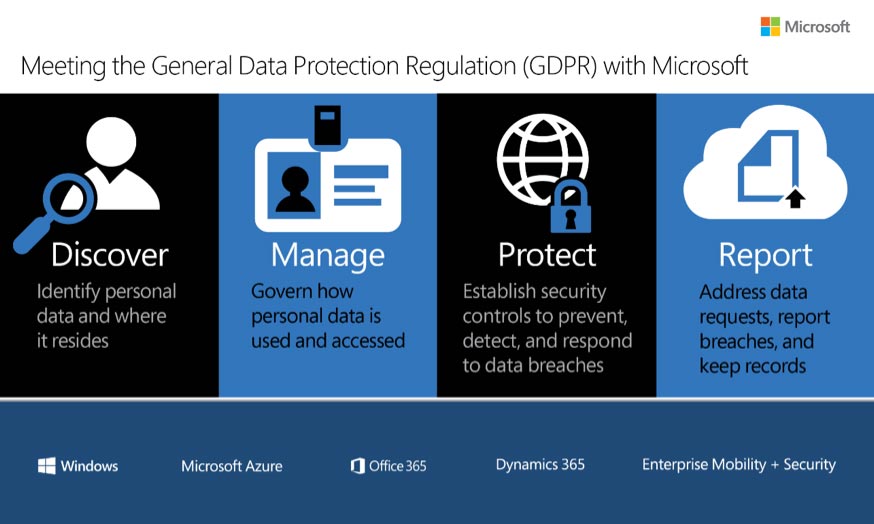As companies increasingly embrace the cloud, they have an unprecedented ability to capture and store massive amounts of data. Consider this, 90 percent of the world’s internet data was generated in the last two years. This exponential growth in the volume of data we generate – coupled with technology that can extract actionable, predictive insights from it – is empowering companies to offer more personalized experiences to customers, achieve unprecedented efficiencies and bring new products and services to market faster than ever. In parallel to this, advancements in business intelligence technology have given organizations the ability to pull insights from this data that are so rich they are predictive in nature. The result: businesses can stay a step ahead of customer expectations and needs, versus merely reacting to them.
As businesses digitally transform to remain competitive and relevant in the 21st century, companies that are using GDPR as a valuable milestone to drive business transformation have emerged with a significant advantage. These companies are already empowering their people to seamlessly collaborate and access information, anywhere and across any device. In addition, they see the potential of using technology like artificial intelligence (AI) and machine learning to stay a step ahead of customer needs and competitive threats.
Microsoft has extensive expertise in protecting data, championing privacy, and complying with complex regulations. Not only have we always kept trust at the heart of technology and developed products and services with privacy, security and transparency in mind, but security is built in end-to-end within our offerings, ranging from identity management to information projection to analytics and threat management. However, decision makers in these organizations know that technology alone is not enough. Innovations like AI have a lot of potential, but if employees are not properly capturing, storing, using and protecting data, the value the technology offers is diminished. After all, only accurate data can yield dependable insights. Furthermore, all the insights in the world won’t help your business if workers across your business aren’t actively using them as part of their everyday jobs.
Here the question arises: How do I bridge the gap between innovation and security? The answer is “manage your data like you manage your money”. Data is the most important asset in a modern company’s business portfolio – and it needs to be managed as such. Here are few tips that will help you in keeping your data secured, while helping you to successfully scale, innovate, and compete in a cloud-first world.
Don’t be distressed by headlines
Headline grabbing cyber-attacks are on the rise, and it’s no surprise. In 2016, data breaches increased by 300 percent. This is stopping some businesses from adopting modern technologies like cloud computing that accelerate digital transformation. However, Gartner estimates that between now and 2020, 95 percent of cloud security breaches will occur due to customer’s neglect. And, with most data breaches being the result of weak passwords, followed by phishing attacks and breaches of third-party services, modern technologies are built around safety, security and privacy. Microsoft spends $US 1 billion on security every year. Windows 10 uses multifactor authentication, meaning users can evolve beyond traditional password logins altogether with biometrics and Windows Hello. Office 365 is also a first line of defence against phishing attacks used to lure users into sharing credentials. So, rather than being alarmed by the headlines, arm yourself with the technologies and knowledge to keep yourself safe.
Prepare your business for change
It’s not just the IT department that must adapt and adopt a cloud-first approach to security, but the entire organization. Security should no longer operate as a siloed IT function, but rather as a fundamental business process that’s aligned to business objectives. It’s essential that you embed security across your entire business network, applications and access points to detect, analyse and block suspicious behaviour. You should also adopt an “assume breach” mind-set. By assuming your network has been breached, you become more vigilant about monitoring patterns of behaviour. This means you’re able to identify real threats and anomalies quickly before they do too much damage.
Educate your employees for change
Employees now define the corporate perimeter, and they are the weakest link in a network as they use their online identities to navigate documents, apps and website online. Even if you have the most impermeable systems and processes in place, a lack of security awareness among employees can be a serious risk. Most breaches today are the result of simple mistakes by employees clicking on rogue links in emails, downloading malicious attachments, or simply not following security policies and training lessons. The first step is to train employees not to open suspicious mails or click on unknown links, and to back up all critical data to the cloud. This will help ensure your business is safe from ransomware attacks. It is also essential to educate your employees to use strong passwords and never to reuse passwords. Consider implementing multi-factor authentication features like Windows Hello, which uses fingerprint and facial recognition technology, or the Windows Authenticator App, which sends a security code to make it even more difficult for hackers to sign in even if they do crack a password.
Update existing infrastructure: cloud helps security meet agility
Many industries and companies are adopting the Internet of Things (IoT) technologies to remain relevant and competitive. But IoT means infinitely more data being stored, and more employees with access to sensitive information. A solid IT infrastructure will determine the capacity to ensure that all this data, and these ‘things’ can be controlled and managed centrally. Organisations may think that strong security measures through processes and systems mean they must forfeit agility. This is not true. With the intelligent cloud, you can be both agile and secure. The intelligent cloud can follow automated rules that reflect a company’s security policies. Setting regular storage updates and automatic security updates means there is less pressure on human capacity. More than 80 percent of attacks target a known vulnerability that could have been prevented with an existing patch. Cloud computing enables the latest patches to be delivered to your IT system every day, or as soon as a new vulnerability is detected. Trusted cloud vendors offer the most up-to-date security, Microsoft for example is home to a 24-7 incidents response team, a digital crimes unit, and encrypts all data in transit between you and our data centres. In addition to managing the security of your own business, you have a role to play in creating a more trusted internet environment for everyone. Ultimately, a digitally competitive company needs digitally savvy employees and consumers with an elevated level of trust in the digital world.
Embracing digital transformation offers every organization an opportunity to better engage with customers, empower employees, and optimize the creation and delivery of products and services but before plunging into a digital transformation, you should explore your choices and engage in a strategic discussion to determine the best way forward.





